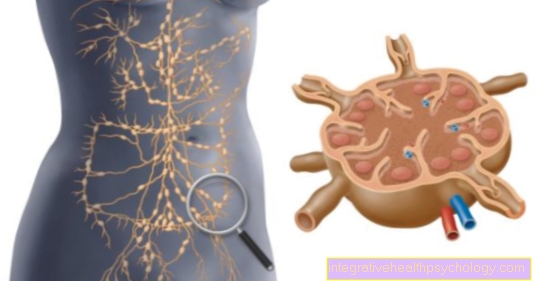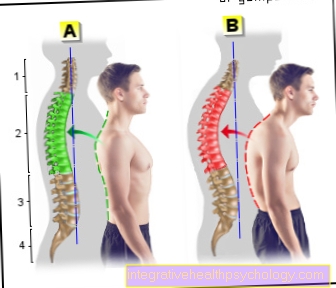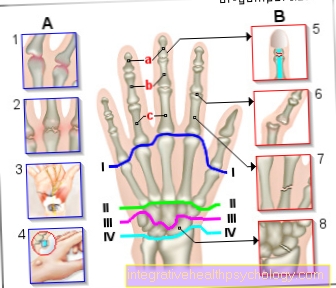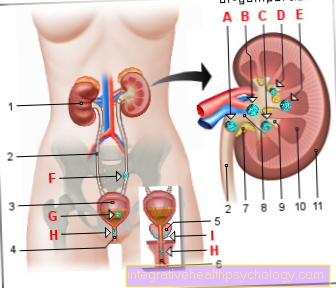Diagnosing dyslexia
Synonyms in a broader sense
Dyslexia, dyslexia, dyslexia isolated or circumscribed reading and spelling weakness, LRS, reading and spelling disorder,, partial poor performance, partial impairment.
definition
Under one Dyslexia one understands specific weaknesses that only show up in reading and (spelling) writing, although no impairment in intellectual development can be determined, so we have a normal to above-average intelligence.
A diagnosis of dyslexia is usually a result of observations that show that there are problems with the written language that are not due to inadequate teaching and that relate solely to reading, writing and spelling.
A specific diagnosis should therefore be a close observation of the child and its performance have preceded. Symptoms are always of a specific nature, which means that not all symptoms always have to apply to a child, conversely, a list of symptoms can never claim to be complete, as new symptoms can always appear.
As a rule, however, the following symptoms can typically be observed in dyslexic children:
- slow and halting reading
- Problems recognizing and naming letters
- confusing letters, either because of their similarity in appearance b - d - p - q (spatial position) or because of their similar sound (d - t, g - k, b - p, ...)
- guessing and thus confusing words
- Problems with repeating long words (e.g. locomotive, ship captain, lighthouse keeper, ...)
- own language problems
- Problems with grinding letters and sounds together
- Many errors in spelling, which have to be examined as part of the diagnosis and assigned to problem areas.
- Problems with writing words that are true to the sound (= words that you write as you speak them, e.g. flower) after dictation (sound synthesis).
- ...
diagnosis

Analogous to the historical change in the concept of dyslexia, differences in diagnosis are also noticeable. There are still different diagnostic procedures and approaches today.
In principle, problems in reading and spelling arise from bad experiences. However, this does not mean that dyslexia is present. In order to be able to make clear statements in this regard, it must be checked whether the problems are not due to other causes (lack of exercise, physical illnesses, other learning problems, ...).
Especially when error types (see definition) accumulate and other typical symptoms become noticeable, a conversation should take place between the parents and the teacher. As a rule, the first diagnostic procedures can take place at school. Should further diagnostic procedures (such as intelligence diagnostics) become necessary, the school psychological service can be called in. However, you can also contact the educational counseling center in your area or a child and adolescent psychologist yourself.
As a rule, a diagnostic procedure should start with a preliminary discussion. During the conversation, individual incidents can be discussed, which may allow conclusions to be drawn about the presence of a reading or writing weakness (dyslexia). These would be, for example, pre-, peri- or postnatal events, early childhood diseases, family and school situation, work behavior, dealing with stressful situations, etc.
Standardized test procedures that can provide information about a child's individual performance should only be used after the first contact. An intelligence test and a reading and spelling test are usually carried out.
The diagnostics not only aim to give the problems a name, but also primarily ensure that targeted and individually oriented support takes place. The two words “support” and “diagnostics” result in the compound word “support diagnostics”, the content of which is discussed below.
Funding diagnosis

A support diagnosis is understood to be a diagnosis that does not resign itself to making a diagnosis, but also claims to make specific statements with regard to appropriate support and therapy.
Funding diagnostics want to prevent the diagnosis of "dyslexia" from recognizing the underlying evil of all problems and allowing one to rest on the diagnosis. Especially in the 70's and 80's when dyslexia was declared a "fad", the diagnosis of dyslexia represented an opportunity to avoid problems in reading and spelling by protecting notes etc.
Under no circumstances should one rest on a support diagnostic. Rather, this specific diagnosis should help to counter problems through specific forms of exercise. Error diagnostics evaluate errors in a special way and assign them to the various learning and support areas in a standardized manner.
Components of funding diagnostics
As already mentioned, the concept of funding diagnostics is made up of two parts of the word. On the one hand, emphasis is placed on a differentiated diagnosis; on the other hand, this diagnosis is also expected to provide targeted statements with regard to individually oriented support.
Funding + diagnostics = funding diagnostics.
Funding diagnostics include:
- An analysis of the basic skills and a learning observation that show the first typical problems (see above)
- Determination of problems and abnormalities in the development of a child (pre-, peri-, postnatal problems, reduced reading consumption within the family, role model character of the parents, ...)
- Diagnostics of intelligence, whereby care should be taken to use intelligence tests that are not based on written language. Such intelligence tests are called "non-verbal intelligence tests". They should avoid that the intelligence is depicted reduced due to the existing problems in reading, writing and spelling by the specific task.
- The determination and recording of the current state of language, reading and spelling development using standardized test procedures
- Comparing the values from the standardized test procedures, i. comparing the scores of the intelligence test with the scores of the reading, language and spelling tests.
The first suspicions can come from the teacher or the parents. It is then advisable to have a conversation between parents and teacher in which problems and the child's learning behavior are addressed and discussed. Unfortunately, teachers cannot cover all testing procedures, which we believe would be more helpful in terms of targeting funding more effectively. Although the criticism that the teacher’s judgment is too subjective and therefore questionable in places, the diagnosis by the school psychological service or a child and adolescent psychologist usually only provides an insight into the performance of the child in relation to the task and the Moment of test execution. They are often subject to the criticism of being "blind to the situation" and thus, despite all the objectivity, do not sufficiently take into account the child's individuality. the further diagnostic measures are then discussed.
Analysis of basic skills
Basic skills are the fundamentals that are of particular importance for the acquisition of the written language.
With regard to the acquisition of reading and (spelling) writing skills, these include:
- fine motor skills (= knowing how a word is written and how to use this knowledge)
- Ability to analyze sounds (sound = letters spoken in the word, which, in contrast to spelling (A, Be, Ce, ...) are only pronounced as they are used in the word: BAUM - B AU M, where B is not used as BE , AU is not spoken as A and U, M is not spoken as EM)
- auditory discrimination skills (ability to perceive even small differences with the ears, e.g. in the sounds: b-d, g-k, ... or in words: pants - rabbit, etc.)
- Kinaesthetic discrimination skills (= ability to carry out movements and to perceive them. In the field of written language acquisition related to the fine movements of the speaking apparatus, e.g. when reading or writing, which in the first time usually always takes place through loud or quiet articulation)
The overcoming / minimization of individual problem areas is all the more likely, the earlier you discover a possible impairment. This is due to the fact that the crucial phases of children's language development have not yet been completed. One way of diagnosing language-related perception lines is, for example, that of Breuer / Weuffen developed "Verbosensomotorischen differentiation tests", by means of which the optical and kinesthetic as well as the melodic and rhythmic basic components of the kindergarten child and / or school child can be checked in the beginning lessons. This is not a test for the classification of certain development levels, but a test that determines the individual level of speech perception performance.
Intelligence diagnostics

Dyslexia (partial performance weakness) implies normal to above-average intelligence. Problems arise in isolation in the area of reading and spelling. Giftedness cannot be ruled out, especially if dyslexia predominates.
Which intelligence test is used to measure intelligence is different. Since the intelligence quotient as such is not a generally valid measure, but only reflects the current level of intelligence in relation to a specific test procedure, it must be noted in an expert report which procedures were used.
Since there are very many different methods for determining the intelligence quotient and thus for measuring intelligence and the individual level of development, a few test methods will only be discussed here as examples. On the one hand, this is due to the fairly frequent use of the HAWIK (Hamburger Wechsler Intelligenztest für Kinder) and the CFT (Culture Fair Intelligence Test).
The HAWIK tests practical, verbal and general intelligence using various sub-tests, such as: picture additions, general knowledge, arithmetic reasoning, etc.
The CFT measures a child's individual ability to recognize rules and identify certain characteristics. It also measures the extent to which the child is able to grasp and solve problems non-verbally. In total, the test consists of five different sub-tests.
Spelling diagnostics
There are many different tests to perform a spell check. Even if many of these test methods have been used for more than 10 years, they are not necessarily out of date, but have been repeatedly adapted and adjusted through new editions.
The various test procedures are adapted to the respective level of performance. This means: There is a certain test procedure that is similar in difficulty to the individual grade levels. As a rule, the number after the name reveals from which school year the procedure is suitable.
Example: DRT 2 stands for Dignostic spelling test for the second year of school, whereby the most suitable time for carrying out a test is precisely determined. In the present example, these are the last two months of the second school year and the first two months of the third school year.
Reading diagnostics
Similar to the area of spelling, reading diagnostics analyzes the errors made in the various areas of reading. In addition to reading words out loud, attention should also be paid to the ability to understand the text.
The ability to read can be subdivided into various sub-areas, which the experienced reader automatically and therefore unconsciously run. For example, we no longer have to analyze and name every single sound (spoken letter / spoken letter combination) to read a word. Experienced readers, for example, recognize certain sounds and words at a glance and name them from memory.
The following table provides information on early diagnostic measures to interpret problems in the area of reading. They can be used in the first year of school, but the children should be given the opportunity to develop in the first few months. For some children, getting into the reading process is not easy; with the necessary amount of practice and habit, initial difficulties can often quickly be put into perspective. Of course, the development should be monitored early and accompanying. A warning should be given here against assigning problems too quickly!
According to the funding diagnostic concept, problems can always be concretely addressed through the learning process observation, without first making extensive diagnoses.
Reading diagnostic sub-areas
- Visual analysis
- Ability to recognize individual letters, both on their own and within a word
- Ability to find matching pairs from upper and lower case letters (e.g .: assignment of M and m)
- Ability to find the letters a word needs to form from a confusion of letters
- Ability to recognize signal groups such as word stems etc.
- Recognize words from a series of similar looking words
- ...
- Sound-letter assignment
- Ability to recognize and pronounce the letters
- Ability to name the vowels a, e, i, o, u
- Ability to pronounce the consonants
- Ability to use the double (mm, nn, ll, ...) and umlauts (ö, ä, ...)
- ...
- Auditory analysis
- Ability to recognize and reproduce the sound at the beginning
- Ability to recognize and reproduce the sound inside a word
- Ability to recognize and reproduce the sound at the end of a word
- Ability to distinguish similar sounding sounds (b - p, d - t, g - k, ...)
- ...
- Auditory visual analysis
- see visual analysis, with the difference that the visual findings should also be named
- Sound synthesis
- Ability to combine sympathetic and vocal sounds (la - le - lu - li, ...)
- Ability to connect letters to form words
- Ability to read words where consonants pile up
- ...
- (meaningful) reading
- Ability to match a word with the appropriate picture
- Ability to assign the appropriate picture to a sentence. Ability to add missing details in the picture based on a read sentence (read - paint - sheets, ...)
- Ability to read simple short texts intelligently
- Ability to express what you have read in your own words
- Ability to comprehensively understand foreign texts
- ...
As in the area of spelling, there are standardized test procedures that examine reading performance. In addition, the reading behavior of a child in everyday life also provides valuable and important information. For example, a standardized test procedure is not absolutely necessary for checking the ability to understand text. This ability can be analyzed using simple procedures as early as the first year of school. These include, for example, so-called reading-painting sheets, in which the child is asked to read a sentence and to add missing objects by painting. Word - image assignments also provide initial conclusions about a child's ability to understand text. In the meantime, additional tasks have also been developed for the secondary school years that determine the understanding of the text.
Summary

The judgment "dyslexia" is not a diagnosis to rest on. In a special way, it is now required that the diagnosis is followed by a suitable and successful therapy. Because of this, after an initial inventory, funding can initially take place in accordance with the diagnostic results, but the funding and therapy themselves also have to be repeatedly checked diagnostically and therapeutically adjusted.
Since the difficulties in reading, writing and spelling also express themselves in the area of general development, the ability to socialize, or in work behavior through problems in structuring tasks, which often lead to total fear of failure or learning blocks, the support diagnostics should be child-oriented be and be carried out by people who are with the child together at least once a week work.
It should always be designed in such a way that it provides valuable information on funding. As a result, the Funding needs determined again and again and diagnostics and therapy have to be adapted and carried out again and again.
Ultimately, the is also for individual therapy trustful contact to the child of particular importance. The psychological level in particular is often forgotten when it comes to funding. But it is particularly important because the child's psyche is affected by the constant feeling of failure. Everyone knows that the feeling of failure is uncomfortable and ultimately leads to self-doubt.The consequence of this is often that you try to avoid these unpleasant situations. Therefore, refusal attitudes up to total learning blocks are not uncommon.
In our opinion, the Combination of school (pedagogy) and therapist (psychology) represent a good combination. With its pedagogical skills, the school could cover the specific and individual support with all didactic measures and methods, while the therapeutic task could be geared towards the child's psyche. Unfortunately, the integration of dyslexia-specific support in special school classes is very difficult, as many children in a class with 25 children, for example, often need individual support. It would be nice if - as in other European countries - every teacher in a class had either a special education teacher or a child and adolescent psychologist at their side, in addition to a reduced class size.
As long as this is not the case, the therapist and class teacher should from time to time cooperatein order to align the therapy with the school subject areas and thus align school + therapy.
More dyslexia issues
- Causes of Dyslexia
- Symptoms of dyslexia
- Early detection of dyslexia
- Diagnosing dyslexia
- Therapy for dyslexia
- Dyslexia - LRS
- The reading and spelling weakness (LRS)
- Partial performance weakness
Related topics
- ADHD
- ADS
- Dyscalculia
- Giftedness
- Poor concentration
- Speech disorders
- Educational games
A list of all topics that we have published under our "Problems with Learning" page can be found under: Problems with Learning A-Z





























